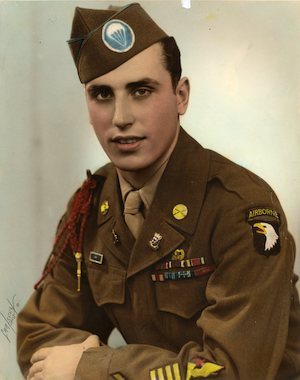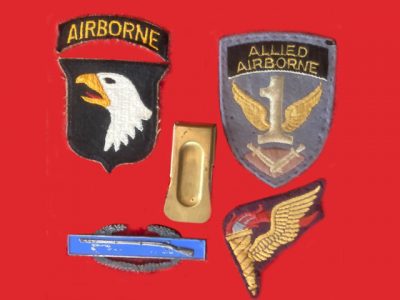Louis Venditti served with the 506th Parachute Infantry Regiment of the legendary 101st Airborne Division. He was one of the “Band of Brothers” made famous by the Stephen Ambrose book and the HBO miniseries. When he returned home from WW ll, he did so in an Army uniform with a unique set of patches and badges not commonly seen.
In the pre-dawn hours of June 6, 1944, Venditti parachuted into Normandy, France, as part of the first wave of allied troops in the massive D-Day Invasion. A recipient of the Purple Heart for wounds received in action, he participated in some of the fiercest combat faced by U.S. troops in Europe. In addition to D-Day, he participated In Operation Market Garden for the liberation of the Netherlands and the Battle of the Bulge.
 At the Battle of the Bulge, in the town of Bastogne, Belgium, the 101st was surrounded by overwhelming German forces. The Germans sent the paratroopers an ultimatum: Surrender or face certain death. The 101st Commander, Brigadier General Tony McAuliffe, replied with one of the best one-word answers in the annals of military history. McAuliffe simply replied “Nuts.” The 101st never did surrender and fought their way into Germany, ending the war at Berchtesgaden, the site of Hitler’s home.
At the Battle of the Bulge, in the town of Bastogne, Belgium, the 101st was surrounded by overwhelming German forces. The Germans sent the paratroopers an ultimatum: Surrender or face certain death. The 101st Commander, Brigadier General Tony McAuliffe, replied with one of the best one-word answers in the annals of military history. McAuliffe simply replied “Nuts.” The 101st never did surrender and fought their way into Germany, ending the war at Berchtesgaden, the site of Hitler’s home.
The items pictured above are actually from Venditti’s uniform. Heading clockwise from the upper left, first and foremost is the “Screaming Eagle” patch of the 101st Airborne Division, worn on Venditti’s left sleeve. Originally established in 1918 as the 101st Division, the “Airborne” tab was picked up when they were designated as one of the two original U.S. Airborne divisions, formed by the U.S. Army in August 1942.
On his right sleeve Venditti was authorized to wear the patch of the 1st Allied Airborne Army. Formed in 1944 by General Eisenhower to centralize command of allied airborne units in Europe, the 101st was under their command for Operation Market Garden and the Battle of the Bulge.
Next is the Pathfinder patch worn on Venditti’s lower left sleeve. Established in 1943, the winged torch of the pathfinder was worn by a select group of volunteers. In small groups, known as “sticks,” they had the perilous job of jumping ahead of the main body of airborne troops to mark landing zones and set up communications for the invading paratroopers.
The Silver Musket on a blue field surrounded by a silver wreath is the Combat Infantryman Badge. Not everyone in the Army, even those who were in combat, qualified for this badge. Created in 1943 to give special recognition to hardships and perils faced by the infantry, it was awarded only to infantrymen who engaged the enemy in ground combat. It is worn on the uniform above all other decorations, medals and badges.
One of the most unique pieces of equipment issued to the D-Day paratroopers was the “cricket” or clicker, located in the center of our photo. Knowing the paratroopers would be landing in the predawn darkness, there was a need for a discrete means of communication among the troops. A simple child’s toy was the answer! One click would be answered by two clicks, establishing an instant form of recognition in the darkness. Pictured here is the actual clicker carried by Venditti when he jumped into Normandy on D-Day.
To view a scene from the 1962 movie “The Longest Day” in which a cricket is used, click here.
Conspicuously absent from this grouping are Venditti’s “jump wings,” the badge of distinction earned by all paratroopers. An all-volunteer group, they received some of the toughest combat training in the Army. Perhaps their mission is best summed up by Major Richard Winters of the 506th Parachute Infantry Regiment. When questioned by a fellow officer about the peril of being surrounded and behind enemy lines, Winters responded, “We’re paratroopers, Lieutenant. We’re supposed to be surrounded.” Louis Venditti passed away on Feb. 18, 2019, and was buried with his coveted jump wings.



0 comments on “A tale of bravery, told through memorabilia”